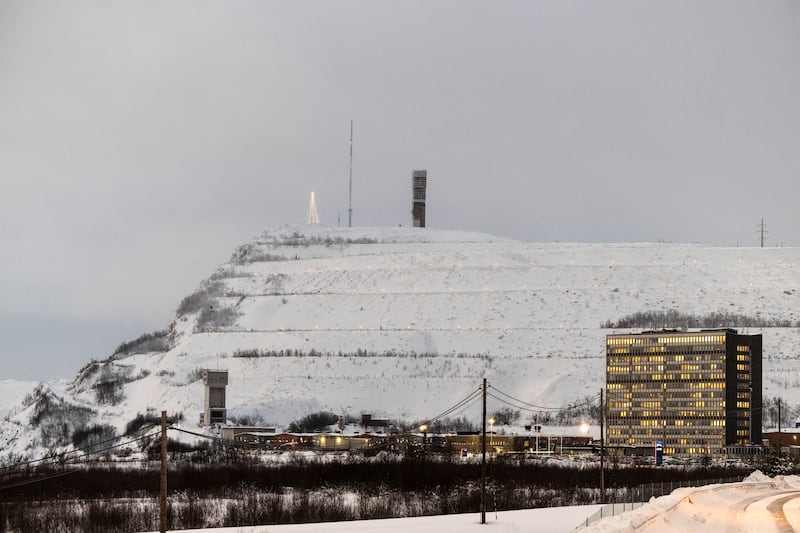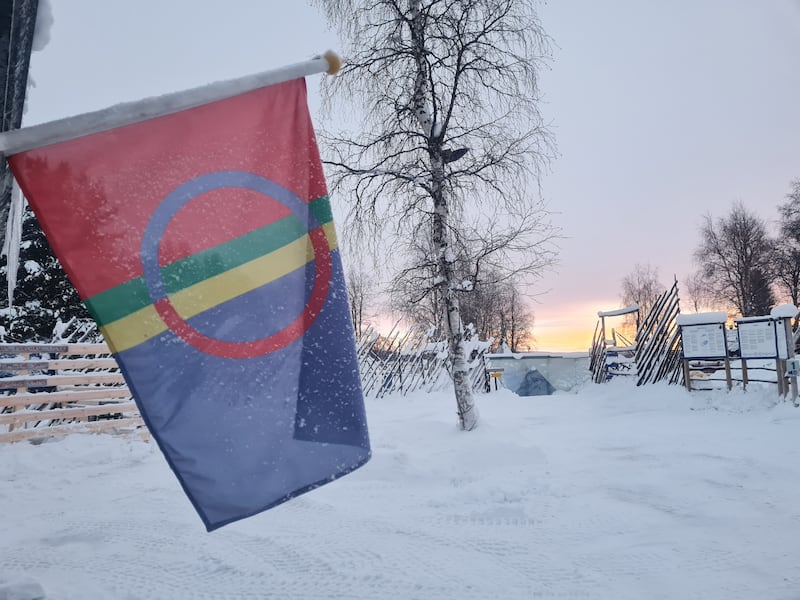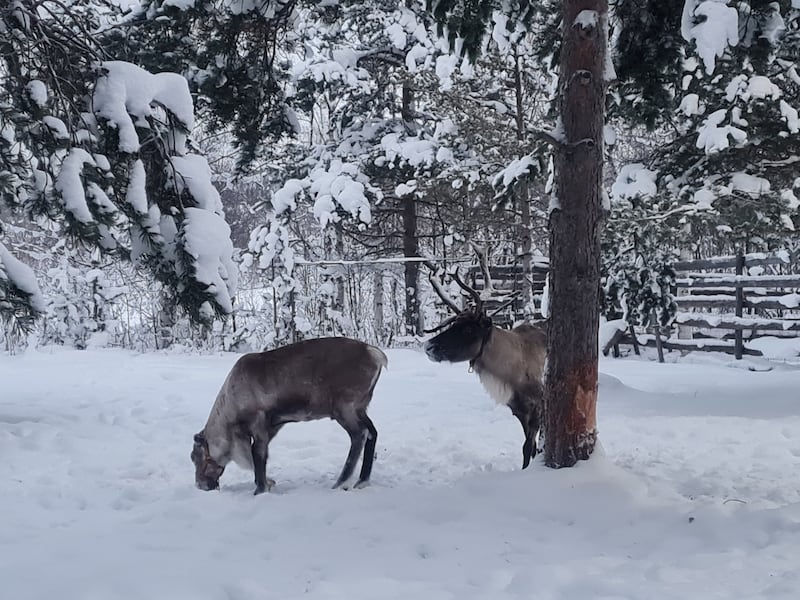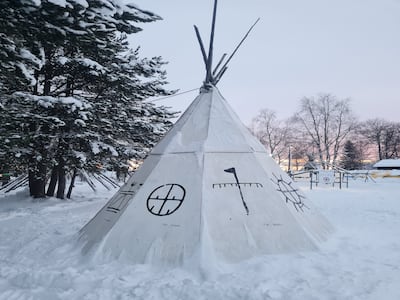On the wall of Ingemar Blind’s snowbound office, 200km north of the Arctic Circle, is pinned a map.
It shows his community’s reindeer traditional herding lands, stretching in a long strip from the mountains of Norway in the high western north where the reindeer and their herders spend their summer, down to the shelter of the winter grazing forests of Sweden in the east.
The map is carefully annotated. The handmade map key reads “migration route”, “narrow passage”, “grazing paddock” and, importantly, “calving grounds”, the southern slopes rich in lichen, moors and streams where female reindeer need undisturbed time to give birth to the herd’s next generation.
Blind (63) is the chairman of the indigenous Sámi village of Girjas, and one of a few thousand people in Sweden who still live by traditional reindeer herding, a way of life that archeological records suggest goes back at least 1,000 years.
The map on his office wall demonstrates the intimate reliance of his community on the land, one of Europe’s last remaining pockets of wilderness, which has been divided and encroached upon by a century of development, by climate change and perhaps now again by a push for a ‘green industrial revolution’ in Sweden’s high north.
Just a few kilometres away from this office, Sweden’s state-owned LKAB mining firm has announced the discovery of Europe’s largest known deposit of rare-earth minerals – materials needed for mobile phones, wind power turbines and electric cars.

“If we’re going to be able to make the green transition, all of these rare-earth elements are important. They’re important for the new technology paving the way for the future of the European Union,” Sweden’s deputy prime minister and energy, business, and industry minister Ebba Busch told The Irish Times as she unveiled the discovery in a hard hat, half a kilometre below the surface within the Kiruna mine.
“This is the million-dollar question: is it possible to combine economic growth while at the same time reaching high-set climate goals?” she said. “And I say the answer is yes.”
In a statement issued after the discovery was announced, the Gabna Sámi community said the new mine would “split a traditional area for Sámi reindeer herding in Kiruna into two disconnected areas” and “cut off the last reindeer trail passing Kiruna”.
‘The water is getting warmer’
Winters were colder when he was young, Blind remembers. The Arctic has warmed at twice the rate of the rest of the world as the blanket of carbon created by the industrial age traps in heat across the planet. It is two degrees warmer on average here than it was before the industrial revolution got under way in earnest in England in the 1830s as coal and iron ore mining fuelled the start of mass production.
The warming has brought uncanny changes to the landscape.
“The water is getting warmer and you’re getting some kind of fish I’ve never seen before. It’s some kind of fish that likes warmer water. They’re coming higher and higher,” Blind says.

The great Torneträsk lake freezes about 40 days fewer than it did at the start of the 1990s. Each additional degree of warmth allows the air to carry 7 per cent more moisture, so the dry frozen winters are giving way to relentless snow.
The Sámi language famously has many words for the shimmering Arctic light and for different qualities of snow, capturing distinctions that for them can be a matter of life or death.
Last winter, Blind recalled coming across animal carcasses in the forest. “It is very disturbing,” he said. “It died a lot of moose. It died a lot of reindeer too. Nothing to eat.”
Mass deaths of grazing animals in the Arctic have been blamed on a kind of snow that Blind said was called “skilzi” or “skildji”. It is caused by the new phenomenon of rain falling on snow, something that should not happen during the Arctic winter. The surface of the snow then freezes, creating a hard ice plate.

Reindeer find food by nudging through snow to find the lichens preserved beneath: skilzi shuts their food behind an unbreakable pane of ice.
There are other factors at work too. The availability of pastures that are rich in lichen fell by 70 per cent in northern Sweden between 1953 and 2013, according to scientific study, as forests with the older trees that the lichens grow among were clear-felled for Sweden’s hungry forestry industry.
Sweden is the world’s second-largest exporter of paper, paper pulp and sawn timber, an industry that, like wood pellet fuel, is often promoted as climate-friendly because wood is biodegradable and trees are replanted. It nevertheless brings profound change to the landscape and severe consequences for biodiversity, because the replacement trees are short-lived and identical, creating vast tracts of tree farms with little wildlife.
“I think the biggest change was when the wood company – they cut all trees down,” Blind said, referring to Sveaskog, the Swedish state forestry company. “When they cut all the trees, the wind came and packed the snow very hard, and the reindeer can’t eat.”
There are now deep fears among the Sámi over what the next wave of green development may bring.
‘Remember, always fight for the land’
Here in Kiruna, a mountain that is half-eaten by the mining of Europe’s biggest iron ore producer looms over a settlement that began in the 1890s. The story told on the LKAB website is that the location of the iron seam was revealed by a member of the Sámi, who sold the information in exchange for 100 Swedish riksdaler and a lifelong exemption from tax.
This part of Sweden is now at the cutting edge of efforts to create a new green industrial revolution. Kiruna is home to some of the world’s most advanced attempts to create steel from iron using hydrogen, something that removes the production of carbon from the process, offering the prospect of decarbonising an industry that accounts for about 7 per cent of the world’s emissions.

It’s on advances such as this that European leaders have pinned their hopes of achieving the EU’s climate goals of cutting greenhouse gas emissions 55 per cent by 2030 and ending the production of combustion engines by 2035, in a bid to avoid the catastrophic levels of climate change that greater warming would bring.
Visiting Kiruna, European Commission president Ursula von der Leyen praised its advances in clean tech and welcomed the rare-earth minerals discovery as “great news” that would help Europe reduce its dependency on such exports from China. The EU would soon introduce new legislation aimed to make it easier for green projects to get permits, she announced.
“I hear over and over again, in these renewable projects, always it’s the permitting question,” Dr von der Leyen said.
The chief executive of LKAB, Jan Mostrom, told The Irish Times that there was a need to ease “layer of layers of rules and regulations” that he said hampered the development of a business that is as green as a mine can be.
“It’s very complicated, and it’s very time consuming to pursue all these environmental permits,” he said.
He acknowledged that there were likely to be “different interests” with the Sámi. “I’m totally confident that we can coexist, but that means that we have to adjust,” he said.
The Sámi parliament, elected to represent the interests of the community, is a stakeholder in the permitting process. Stefan Mikaelsson, the vice-chairman of the parliament’s board, told journalists that preserving Europe’s remaining wildlife was vital for the continent along with cutting emissions, and that no one should pretend that preserving the Amazon rainforest alone would allow for unlimited development in Europe.
“We don’t want any more extraction of natural resources,” Mikaelsson said. “We have to change as a continent our habits and decisions.”
Speaking at his desk as snow gathered on the windowsill outside, Blind smiled with confidence.

“They take everything they can, but now it’s getting harder and harder for the Swedish government to take things. We were in the great court,” he recalled.
He was remembering the great legal victory of 2020, when Girjas village won against the state in the Swedish supreme court. The battle had begun in the early 2000s, when reindeer herders found that permits had been granted inconsiderately to hunters in their herding lands, leading to gunshots and disturbance that would scatter their reindeer during vital times of their life cycle.
“Total chaos. There was a lot of people everywhere ... and dogs, hunting dogs. Then we decided to sue the state,” Blind recalled.
The ruling determined that it was the right of the Sámi administrative districts, and not the Swedish state, to decide whether others could hunt or fish in the lands they use.
“Here there have been Sámi people for thousands of years. You can’t even see that they have been here – they lived so carefully,” Blind said.
“My uncle once said: without land, no reindeer. Very simple. Remember, always fight for the land. It’s the land of each. It belongs to everybody. It’s forbidden to destroy it. Just use it, carefully. That’s the point.”


















